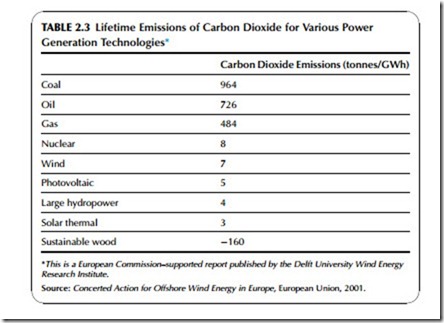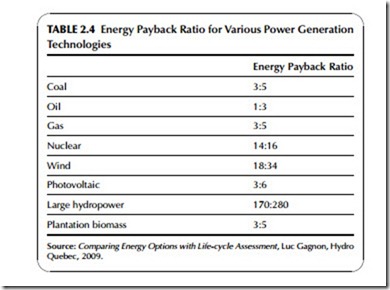LIFE-CYCLE ASSESSMENT
Another important tool for establishing the relative performance of power generation technologies is a life-cycle assessment. The aim of a life-cycle assessment is to measure the performance of a power plant with reference to one or more parameters, such as its emissions of carbon dioxide or the energy efficiency of its power generation. The assessment covers the complete life cycle of the plant starting from the manufacture of the components that were used to construct it and ending with its decommissioning.
The LCOE calculation discussed earlier is a type of life-cycle assessment of the economic performance of a power station. If one were instead examining the lifetime amount of carbon dioxide produced by a fossil fuel–fired power plant, one would examine not only the amount produced by burning the fuel in the plant, but also that produced when electricity or some other form of energy was used to manufacture the components used to build the plant, and any produced when the plant was dismantled and recycled. All these quantities can then be added up and divided by the amount of electricity the plant generates to pro- vide a figure for the amount of carbon dioxide for each unit of power.
When carbon dioxide emissions are studied figures show, as would be expected, that coal-, gas-, and oil-fired power plants release massively more carbon dioxide for each unit of electricity they produce than do most renewable technologies. Typical figures are given in Table 2.3. Similar results are found for other common combustion plant emissions such as sulfur dioxide, carbon monoxide, and nitrogen oxide.
There are other types of life-cycle assessment that can be carried out. Another of relevance to power plant performance is the total energy balance of a plant. This involves a calculation of the number of units of energy a power station produces for each unit of energy it consumes over its lifetime. Energy is used to manufacture components for a power plant. For a fossil fuel plant,
energy is used to harvest and deliver the combustion fuel to a power plant. The fuel itself contains energy that is consumed. And energy is consumed during the decommissioning of a power plant. All these units of energy must be added together and then divided by the total number of units of energy the power station delivers.
When the energy content of the fuel is included in the calculation, renewable generating technologies often appear as relatively poor performers. This is because while a thermal power plant can convert between 45% and 60% of the energy in its fuel into electricity, a wind turbine will generally struggle to convert more than 40% of the wind energy into electrical energy and a solar plant typically less than 20%. On the other hand, while these renewable efficien- cies are relatively low, the energy that is not converted is not wasted—it simply isn’t used. The energy from a combustion fuel that is not converted into electricity is released as waste heat.
A more useful comparison can be made by excluding the actual energy con- tent of the energy source. One set of energy payback ratios calculated on this basis is shown in Table 2.4. The figures in the table confirm that when the energy source is excluded most renewable technologies score more highly than fossil fuel power plants on this measure, though the manufacture of solar cells is relatively energy intensive, making the energy payback ratio for this technology low. Some newer solar photovoltaic fabrication technologies will have better
energy payback ratios than shown in Table 2.4, which is based on silicon solar cells. Biomass scores similarly to coal- and gas-fired power plants on this mea- sure because the power plant technologies are relatively similar. Hydropower, wind power, and nuclear power are the best-performing technologies based on these figures.

